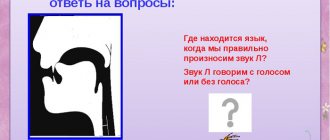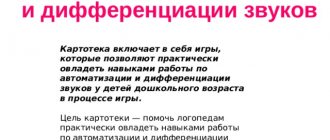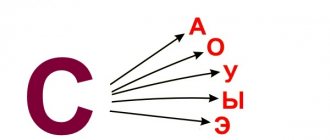Causes of rhotacism and pararotacism
The main causes of defective pronunciation of [P] and [Pb]:
- Short hyoid frenulum.
- Narrow, high palatine vault.
- Narrowed or massive tongue.
- Reduced tone of the lingual muscle, its low plasticity.
- Lack of skill to perform targeted, precise manipulations of the tongue.
- Impaired phonemic hearing.
Often rhotacism appears with simple dyslalia, when the only speech disorder is the incorrect pronunciation of one sound. It is often part of complex dyslalia if the pronunciation of several groups of sounds is simultaneously impaired, for example, combined with lambdacism or paralambdacism. Rotacism can appear simultaneously with severe speech defects: dysarthria, alalia, rhinolalia.
Forms of rhotacism and pararotacism
There are separate independent forms of rotacism. They differ in the place and mechanism of phoneme creation:
- Protori (single-strike). With correct localization, the anterior edge of the tongue touches the alveoli once, and prolonged vibration is not created. The sound of [D] is heard; it is impossible to reproduce a prolonged growl.
- Side. When phonemes occur, the side of the tongue vibrates. The bond breaks between it and the molars. Instead of the correct [P], the sound [Rl] is heard.
- Buccal. The air escapes between the lateral edge of the tongue and the upper molars, and an oscillatory movement of one or two cheeks occurs. The buccal type of rhotacism is the rarest in speech therapy.
- Interdental (interdental). When producing phonemes, the front part of the tongue is located between the incisors.
- Labiodental. Defect [P] and [Pb], formed when oscillatory movements occur between the lip and incisors.
- Laryngeal (larynx) . It is observed in extrapyramidal disorders, as well as in rhinolalia. Sound is created by vibration of the connected vocal cords.
- Nasal. Oscillatory movements appear between the back of the velum and the pharyngeal wall. It is noted in the case of partial velopharyngeal closure due to a congenital anomaly in the form of a shortened soft palate.
- Pharyngeal (pharyngeal). The appearance of a wheezing sound between the root of the tongue and the posterior pharyngeal wall.
- Bilabial (bilabial). The defective phoneme is created by vibrating the lips. With this rhotacism, the sound [Prr] or coachman [R] appears.
- Gorlova. There are two subspecies - velar and uvular. In velar rhotacism, the root of the tongue forms a fissure with the lower part of the soft palate. The escaping stream of air causes an uncontrollable trembling of the soft palate, provoking the occurrence of noise; together with the voice, it causes a kind of growl. The uvular pronunciation of the sound [P] involves trembling of the uvula. A clear rumble is heard. Guttural rhotacism may be colloquially called burr.
- Nasal pronunciation [R]. The root of the tongue is pressed against the soft palate, the air is exhaled through the nose. In addition, there are separate types of pararotacism. The most common replacements for [P] are [Rb], [L], [D], [V], [Y], [Y], [G], [L].
In addition to the above types, the absence of [P] and [Pb] is possible; this occurs if the articulatory structure of the sound is completely unformed.
Usually, each form of rhotacism affects, in addition to the solid [P], the paired [Pb]. Sometimes, if there is a defect in the hard sound, the soft pair does not suffer. Less commonly, the opposite phenomenon is observed.






